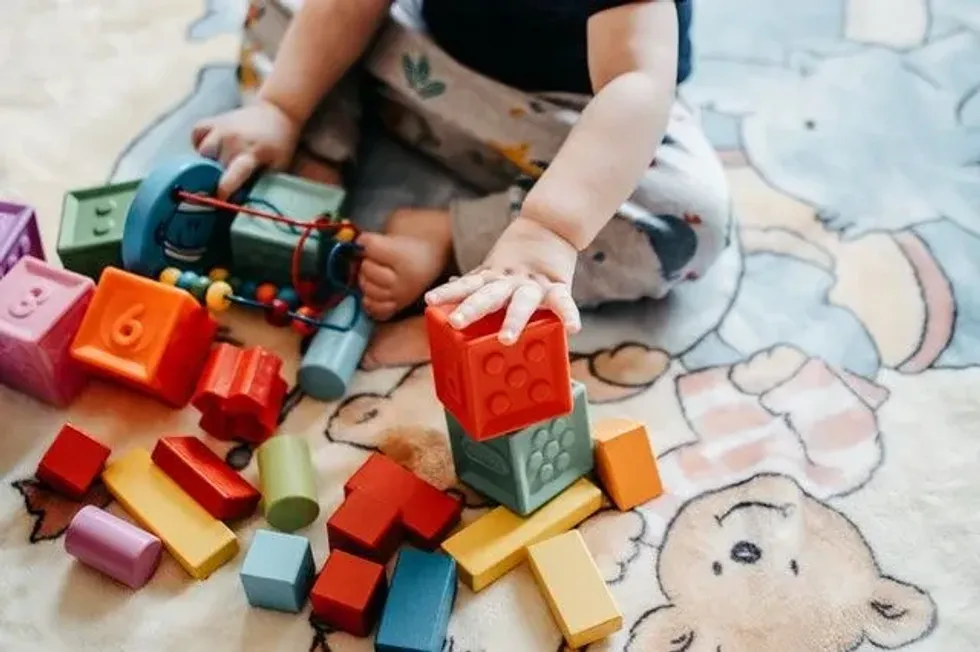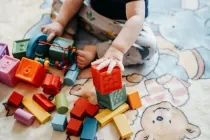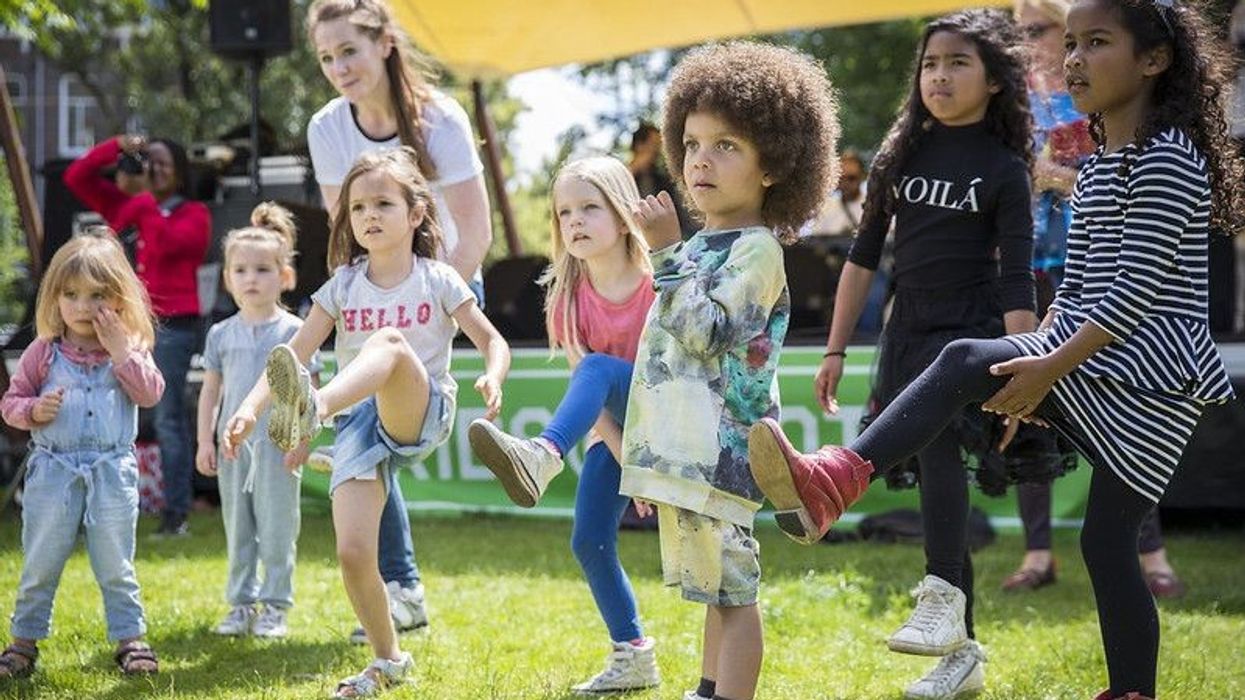26 Activities For 6 Month Old Development, Learning, And Fun

Content
- Tummy Time
- Play Peekaboo
- Tower Building With Blocks
- Nursery Rhyme Time
- Reading Corner
- Splishy Splashy
- Bubbles Bubbles Bubbles
- Walk In The Woods
- On The Ball
- Water World
- Hide And Seek
- Shake It!
- Bouncing Baby
- Art Attack
- Reel It In
- Baby Crunches
- Reach For The Stars
- Baby Bicycles
- Mirror Mirror On The Wall
- Drummer In The Band
- Tidying Up
- Overload
- Hiding Objects
- Fabric Exploration
- Anatomy Lesson
- Baby Massage
So your baby is now 6 months old, how has half a year gone by already?
Your baby may be sitting up now by themselves and you might be able soon to see their first tooth appear! Your baby is on a developmental roll at the moment, and you can help them by incorporating some fun learning activities into their daily routine.
There are so many games and activities you can have a go at playing with them. Playing with your child is not only great for bonding with them but is also great for developing their physical, cognitive, emotional, and linguistic skills.
We hope you enjoy these 6-month-old baby activities for development, and never find yourself out of ideas to explore on a rainy day! For more advice as your baby grows, check out our example 7-month-old schedule and 8-month-old schedule ideas.
Tummy Time
What: This is one of the best sensory activities for 6-month-old babies. Place your baby down on their tummy so that they can develop their upper body muscles, particularly those of the back, neck, and shoulders.
How: You can put your baby down on their play mat for tummy time and let them play with toys at the same time. You can also put your baby on your chest and blend tummy time with cuddle time!
You can also hold your baby's tummy down in the 'football hold' position. All these are ways to incorporate tummy time into your baby's day.
Where: In bed or on the sofa on your chest, on the floor (as long as it's not too cold and is free of anything that could hurt your baby, including splinters from floorboards), or on your arm as you move about the house.
Why: Tummy time activities for 6 month old babies are great for developing the core muscles of the upper body. It's great for developing motor skills too as it prepares your baby for crawling.
It develops hand-eye coordination and balance and is also good for sensory development as your baby is able to explore the textures of your carpet, their play mat, or your skin.
Play Peekaboo
What: A simple game most of us will already be familiar with: hiding your face behind your hands and then revealing it again to shrieks of laughter!
How: Hide your face and when you reveal it again say "Peekaboo!". You can also hide toys behind your back or under a blanket and reveal them in the same way.
Where: You can play peekaboo anywhere.
Why: Peekaboo develops a baby's understanding of object permanence, which is the realization that even though something disappears from sight, it continues to exist. Peekaboo also develops a baby's ability to problem-solve and improves their motor skills as they might want to reach out to touch your face or the hidden object, improving balance and hand-eye coordination.
This activity is also great for social development and communication skills, as babies learn to play with others.
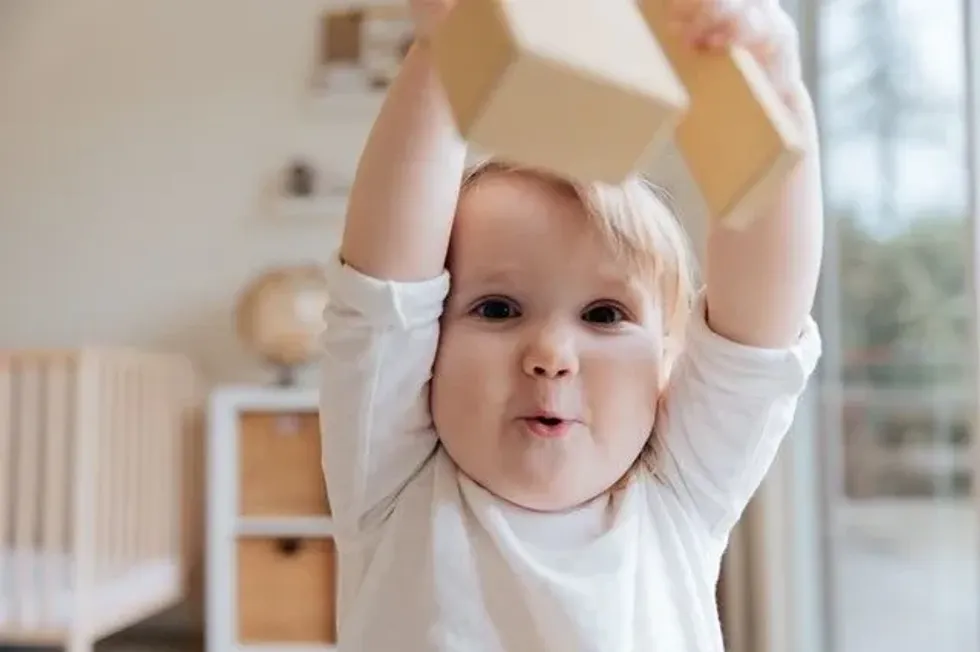
Tower Building With Blocks
What: Using wooden blocks to build towers.
How: Give your baby coloured blocks to play with and get them to try building towers with the blocks. At 6 months your little one will find block-stacking fascinating and will love knocking their towers down afterward.
Where: You can do this in your living room or wherever your baby's play area is. You will need a flat surface to do this on.
Why: This is one of the best games for a 6-month-old baby to work on the development of their hand-eye coordination and fine motor skills.
Nursery Rhyme Time
What: Nursery rhymes with movement.
How: Sing songs like your favorite nursery rhymes to your baby and get them used to copying movements along to the rhythm. You can help them move their bodies to the tune and sing clapping games like pat-a-cake which requires the baby's participation.
Where: You can do this anywhere, on the bus, in bed, in the park...
Why: Singing nursery rhymes helps with babies' speech development and understanding of the rhythm of speech. They also develop their musical understanding and awareness of rhyme. Babies love dancing and music, so this activity should be a win! You don't need any toys for this either, so you can do it anywhere and any time.
Reading Corner
What: Reading board books and picture books.
How: Sit yourself down with your baby and open a book up for a visually stimulating experience and a language lesson. Describe what you see in the illustrations in the book and read the words slowly to allow your baby time to associate the words with the pictures.
Where: This is one of the best learning activities for 6-month-old babies to do at bedtime as it is a relaxing bonding activity that can help your little one unwind before bed. Do it in bed or anywhere else that is quiet and cozy.
Why: Reading is a great bonding activity to do with children at 6 months old. It is great for language development and literacy skills. You can never start too young when it comes to reading.
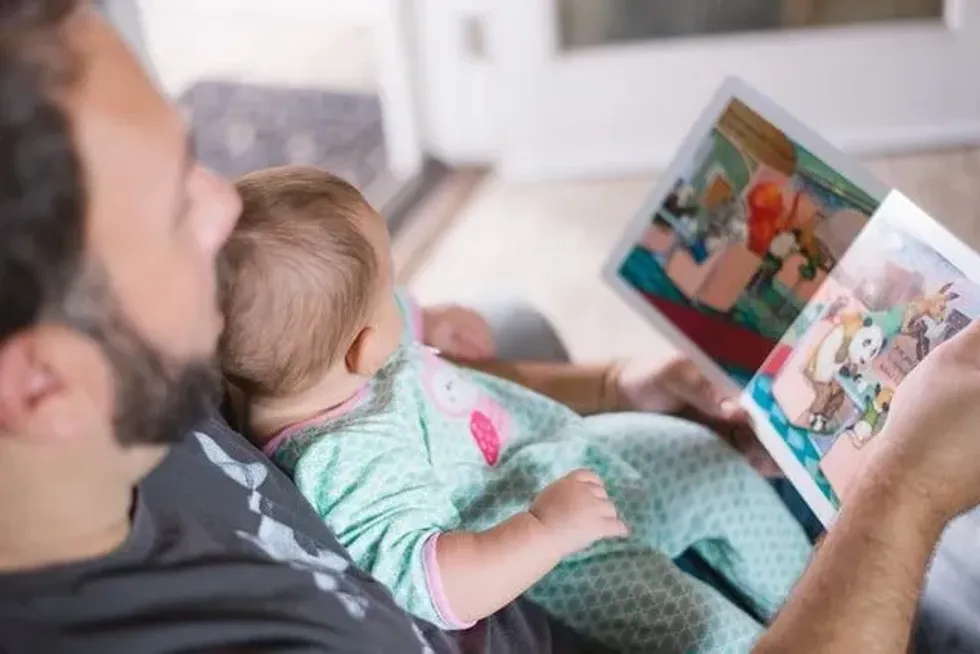
Splishy Splashy
What: Water play.
How: Fill a paddling pool with a few inches of water and let your baby splash around in the water with cups, balls, and other toys. Make sure not to leave them unattended, even for a moment. You can hold your baby upright in the water or get in the bath or pool with them.
Where: You can do this outside in the garden on a sunny day making it one of the best summer activities for a 6-month-old, or in the bathtub on a cold day!
Why: Bath time both indoors and outdoors is a great sensory activity for babies.
Bubbles Bubbles Bubbles
What: Bubble play.
How: Blow bubbles for your baby to pop!
Where: A great activity to do outdoors. If you are looking for fun outdoor activities for 6-month-olds, you can do this anywhere: the park, your garden...
Why: Watching bubbles floating around is a beautiful sight in itself, and is also great for developing gross motor skills as babies try to pop the bubbles with their fingers. Babies love bubbles so this is a great activity to distract your baby whenever they are feeling off!
Walk In The Woods
What: Baby nature walk.
How: Take your baby out for a walk in nature. Take them in a sling so you can venture off the beaten path. Point out the things you can see and hear around you, including flowers, leaves, grass, birds, and insects.
Where: Any outdoor green space, for example, a local park.
Why: Nature walks are great for both moms and babies as being out in nature is therapeutic and promotes wellbeing in us all. Exploring the things you see around you in nature is a great way to stimulate your baby's senses of touch, smell, and hearing.
On The Ball
What: Ball games.
How: Roll a ball back and forth with your baby in the grass.
Where: This activity can be done anywhere, but is a nice activity to do outdoors in the grass.
Why: This is a fun and easy game to play with your little one, and helps them develop their gross motor skills. It is also a great game to get them used to back and forth interaction.
Water World
What: Sensory water bin.
How: Like the baby paddling pool activity, you can fill a smaller container with water and fill it with water toys, cups, and plastic bottles. Let your little one splash around and develop their motor skills at the same time as they use the cups and containers to collect water and pour it out again.
Where: You can do this outside on a warm sunny day.
Why: This is one of the most fun activities for 6-month-old baby girls and boys. It is refreshing on a warm day and is a great sensory experience for little ones.
Hide And Seek
What: An adapted version of the game we all know and love.
How: This is a basic version of hide and seek, as your baby won't be able to count yet or come and find you! Get a member of your family to hide behind a door, piece of furniture, or blanket and get them to call out your baby's name.
See if your baby can recognize the person's voice and work out where it's coming from!
Where: Do this in one room in the house so that your baby can hear their name being called.
Why: This develops your baby's auditory sense skills and gets them used to identifying sounds and working out where they are coming from.
Shake It!
What: Homemade rattle.
How: Fill a small container with rice, lentils, cereal, or other dried grains and shut the lid firmly. Let your baby shake the container like a rattle. Choose a transparent container so that your baby can work out what is making the rattling sound inside the box.
Where: You can do this at home.
Why: This develops your baby's appreciation of cause and effect. Your baby will work out that the cereal is making the noise, and will be fascinated by the notion of cause and effect.
Bouncing Baby
What: Getting your baby to practice standing while you take all the weight off their legs by holding them.
How: This is a physical activity to get your baby used to putting weight on their legs, in preparation for standing. Hold their hands on a soft surface like a mattress and get gently bounce them up and down. Baby can't hold their weight at this age, so don't let go!
Where: You can do this on a bed, sofa, or other soft surfaces.
Why: This helps with your baby's physical development and develops their muscle strength, range of motion and balancing skills.
Art Attack
What: Yummy arts and crafts.
How: Provide your baby with different colored purees (mash some peas up, mash some strawberries up), and give your baby a big piece of paper. Let them get mucky with the puree and use the colored purees to make patterns and handprints on the paper.
Added bonus: they will also lick their hands and eat some of the purees at the same time!
Where: Outdoors in the garden or inside with something put down on the floor to protect the carpet from the puree.
Why: This is a really fun activity for a baby. It provides visual stimulation, taste stimulation, and tactile perception. It also lets your baby have fun while exploring different tastes and textures, and allows them to get messy and practice their creative skills at the same time! You might want to follow up with bath time!
Reel It In
What: Playing with a toy on a string.
How: Get a toy on a string and pull the toy towards you by its string. Try to get your baby to move towards the toy.
Where: You can do this anywhere, but a smooth floor is best.
Why: This entertaining game develops their hand-eye coordination skills, their physical dexterity, and their strength.
Baby Crunches
What: Baby sit-ups.
How: Sit on your bed with your legs outstretched and your baby sitting on you, facing you. Hold their hands and lower them down onto their back before pulling them gently upright.
Where: You can do this in bed or on the sofa, or anywhere that is comfortable for you to sit back on.
Why: This game develops their physical skills such as muscle control. This prepares a baby for pulling themselves upright and sitting up by themselves.
Reach For The Stars
What: String pulling.
How: Get a skein of wool and dangle it above your baby. Get your baby to reach out to grasp the end of the skein.
Where: You can do this anywhere, but indoors is best as if there is a breeze it could be impossible for your baby to catch the string! This makes this one of the best winter activities for a 6-month-old as it is best enjoyed indoors.
Why: This gets your baby to practice grasping objects, and develops their grip strength and hand-eye coordination which are both skills that a 6-month-old should be developing.
Baby Bicycles
What: A baby exercise activity.
How: Get your baby to lie on their back and gently cycle their legs for them with your hands.
Where: You can do this on the bed or anywhere else baby is comfortable lying down.
Why: This game is very simple but increases your baby's range of motion and muscle strength.
Mirror Mirror On The Wall
What: Play with mirrors.
How: Sit down with your baby in front of a mirror and see if they can recognize themselves.
Where: In front of a mirror.
Why: This game is fascinating for infants. Your baby will be amazed at seeing their own face and body in the mirror and may try doing different movements and expressions to see if the reflection in the mirror does the same.
Drummer In The Band
What: Getting your baby to experiment with sound.
How: Get out pots and pans, spoons and ladles and let your baby bash things about to make percussive noises.
Where: You can do this in the kitchen while you prepare your baby's lunch!
Why: This is really fun for little ones as they get to explore cause and effect and it may prepare them for a future career as a drummer!
Tidying Up
What: Getting your baby to help clean their space after play.
How: You can get your baby to help you out when you tidy their toys away. Let them help you dropping their toys into their toy box.
Where: Do this at home or anywhere you need to pack things away with your baby.
Why: This not only gets baby to appreciate the fact that things need to be stored away after use, but also develops their fine motor abilities as they practice picking items up and dropping them into containers.
Overload
What: Helping your baby to understand physical limitations and quantities.
How: Hand your baby some blocks or toys, and keep handing them more so that they have to drop some items in order to accommodate more.
Where: You can do this anywhere, but it's an easy one to do indoors in their play area.
Why: This game helps them understand physical limitations and how large quantities can overwhelm physical capacity.
Hiding Objects
What: Playing with the idea of object permanence.
How: Get some cups and hide objects beneath them. See if your baby can put two and two together and realize that the hidden object is now under the cup.
Where: Do this on a flat surface.
Why: This game can help your baby appreciate object permanence.
Fabric Exploration
What: Exploring different fabric textures with your baby.
How: Get different fabrics, clothes, tea towels, or tissues and brush them over your baby's skin for a sensory tactile experience.
Where: Do this in your bedroom or any other room in which baby feels calm.
Why: This is a lovely activity to do with your baby. It is a sensory experience and gives your baby a chance to experience different textures and physical sensations as the fabric brushes against their skin.
Anatomy Lesson
What: Helping your baby to understand their own anatomy.
How: Explore your baby's body with them, tickling their limbs, neck, face, and torso and naming each body part as you go.
Where: You can do this in bed or at bath time.
Why: This game is a lovely intimate activity to do with your baby and gets them familiar with the names for different body parts. It also gets them to connect to body-awareness.
Baby Massage
What: Massage.
How: Give your 6-month-old baby a massage with some nourishing oil and a drop or two of essential oil!
Where: This is a lovely one to do before bed or before nap time to relax your baby.
Why: This is a deeply relaxing activity to do with your baby. Not only is it a bonding activity but massage has also been proven to fortify the immune system and reduce stress in babies.
If you found this article helpful, then why not take a look at our top tips for surviving the 8 month sleep regression or our sample 9-month-old schedule?
We Want Your Photos!
More for You
See All
Bachelor of Science specializing in Human Anatomy

Joan AgieBachelor of Science specializing in Human Anatomy
With 3+ years of research and content writing experience across several niches, especially on education, technology, and business topics. Joan holds a Bachelor’s degree in Human Anatomy from the Federal University of Technology, Akure, Nigeria, and has worked as a researcher and writer for organizations across Nigeria, the US, the UK, and Germany. Joan enjoys meditation, watching movies, and learning new languages in her free time.
Disclaimer
1) Kidadl is independent and to make our service free to you the reader we are supported by advertising. We hope you love our recommendations for products and services! What we suggest is selected independently by the Kidadl team. If you purchase using the Buy Now button we may earn a small commission. This does not influence our choices. Prices are correct and items are available at the time the article was published but we cannot guarantee that on the time of reading. Please note that Kidadl is a participant in the Amazon Services LLC Associates Program, an affiliate advertising program designed to provide a means for sites to earn advertising fees by advertising and linking to Amazon. We also link to other websites, but are not responsible for their content.
2) At Kidadl, we strive to recommend the very best activities and events. We will always aim to give you accurate information at the date of publication - however, information does change, so it’s important you do your own research, double-check and make the decision that is right for your family. We recognise that not all activities and ideas are appropriate for all children and families or in all circumstances. Our recommended activities are based on age but these are a guide. We recommend that these ideas are used as inspiration, that ideas are undertaken with appropriate adult supervision, and that each adult uses their own discretion and knowledge of their children to consider the safety and suitability. Kidadl cannot accept liability for the execution of these ideas, and parental supervision is advised at all times, as safety is paramount. Anyone using the information provided by Kidadl does so at their own risk and we can not accept liability if things go wrong.
3) Because we are an educational resource, we have quotes and facts about a range of historical and modern figures. We do not endorse the actions of or rhetoric of all the people included in these collections, but we think they are important for growing minds to learn about under the guidance of parents or guardians.

